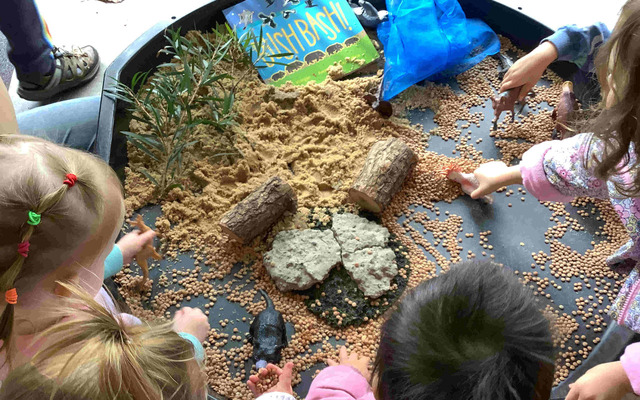

What is small world play?
‘Small world play’ is exactly what the name suggests—play with small props such as toys, figurines, found or loose objects, and natural materials within miniature environments. Through small world play children can enact different scenes and situations. They use their imaginations, stories they’ve heard and/or their lived experiences to create, make connections, and problem-solve.
The possibilities for small world play are endless. Examples include natural habitats (eg a forest, beach or jungle); built habitats (eg a city, construction site or farm); or fantasy worlds (eg a fairy garden, dinosaur world or an alien planet). Depending on children’s imaginations and interests, some scenes may represent real-life and imaginary settings at the same time!
As with all play-based learning experiences, using children’s interests and ideas is a great starting point for setting up small world play. This encourages children to use their own knowledge and their natural curiosity to explore and learn in situations that are meaningful to them.
How does small world play support children’s learning and development?
Imagination and Creativity
Small world play is ‘open-ended’, meaning it has no set rules or expected outcomes—there is no ‘right’ or ‘wrong’ way to do small world play. This leaves children free to go in any direction, and to use their creativity and imaginations to invent scenarios, dialogues and activities that bring the small world to life for them in the way they want.
Language and Communication Skills
Whether playing on their own or with others, small world play offers many opportunities for children to practice and develop their language skills. They invent and speak the dialogue of the characters in their small world, narrate scenarios or talk and negotiate with peers and adults as the play unfolds. This helps children to practice arranging and expressing their thoughts and ideas to others.
Cognitive Development
Through small world play, children can explore and experiment with cause and effect and develop their ability to reason. As they play and imagine, children can test hypotheses and solve problems. There are also many opportunities for developing emerging numeracy skills and concepts, such as counting, calculating, comparing shapes and sizes and sequencing in small world play.
Social Skills
When engaging in small world play with others, children have opportunities to connect with others and to practice social skills such as sharing, turn-taking, listening to others, negotiating and expressing themselves to others. Children may also use small world play scenarios to explore familiar social situations and behaviours, for example, going to the shops, having a family meal or having a play date with a friend.
Physically
Manipulating the objects used in small world play helps children develop their fine motor (small muscle) skills and hand-eye coordination. Depending on the materials used, small world play can also engage multiple senses. Natural items such as sand, water, leaves, and pebbles can add a tactile dimension to the play, and visual and auditory elements can also be incorporated to create a rich sensory experience.
Setting up small world play spaces
You can buy ready-made small world play sets from toy and educational resource stockists. However, setting up a small world yourself, with input from the child or children who will use it, will help to ensure that the set up reflects their interests and captures their imaginations.
Choose a defined space for the small play
It can be helpful to set up small world play in or on easily defined or contained spaces, such as:
- boxes
- tubs
- tables
- mats or fabric pieces
- trays
Create a small world play base
This will largely depend on what the small world scene will be — if it is an underwater world, it might be clear or coloured water in a container, or an alien planet base may be made of sand and pebbles. When choosing the base for the play, it is important to consider the child or children’s sensory needs. Ideas for small world play base items include:
- sand
- soil
- pebbles or rocks
- leaves
- water (clear or coloured)
- fabrics
- artificial grass
- playdough, plasticine/modelling clay
- paper
- natural or dyed grains and pulses such as dried chickpeas, rice, corn, pasta shapes
- homemade slime or ‘goop’
Select items to set the scene
As for pretty much all aspects of small world play, the items included to create the scenery, characters and/or creatures of the small world are only limited by the imagination – they just need to be small enough to be included in the play*. Some potential items include:
- loose parts (ie items with no set purpose that can be moved around and used alone or combined with other materials as children play and explore)
- animal and people figurines (real or imaginary)
- small toys such as toy vehicles, doll-house furniture
- fabric pieces
- small containers
- construction blocks and building toys
- natural items such as shells, trigs, gumnuts, cicada shells
* It is important to ensure that all items included in small world play set ups are safe and age and developmentally appropriate. Check to ensure that the items included are non-toxic and are not potential choking hazards for young children.
Conclusion
Small world play nurtures children’s creativity and their cognitive, physical, language and social skills through imaginative play that helps them connect with and reflect upon what they see, hear, feel and think in their everyday lives. With the gentle guidance and thoughtful engagement of their parents and carers, small world play is a fantastic way for children to learn and make sense of their world.
Contact Us
If you have any questions or would like more information, please email us at childrensservices@theinfantshome.org.au.